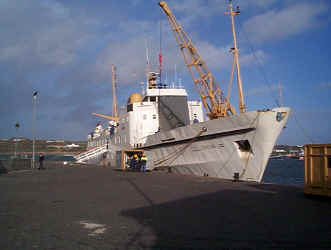Visit your favourite destinations |
| A Report from birdtours.co.uk |
The Scillonian Pelagic,
Flight Identification of European Seabirds
|
The Scillonian Pelagic has become an annual ritual for many UK birders. Others travel from as far afield as Holland, Belgium and Finland to see Western Palearctic birds that are often very difficult to see from the mainland. Top of everyone's wish list is the enigmatic Wilson's Petrel, which seems to be seen on almost every trip.
Ideal conditions would be strong south-westerlies. However, the Scillonian is a peculiarly seasick inducing vessel. I believe it has a flat bottom in order to get through shallow waters in the Scillies, and hence it wallows appallingly. I once saw more than half the passengers being violently sick, (and I was one of them!)

On my own Pelagic trip, it was flat calm. Our first bird was a Gannet after about two hours sailing! Amazingly we still managed to connect with a Wilson's Petrel. (Big Shearwaters, however, were noticeable by their absence.)
Hints for a successful trip:
Derek Smith takes up the story, with his account of the August 2000 trip:
My first trip on the pelagic last Sunday went well, not least the calm conditions ensuring a healthy group of passengers. I didn't see anyone being ill, although tiredness got the better of a few birders during quiet periods. It was very warm on deck, and there were a lot of sunburnt faces at the end of the day.
My friend and I left Canterbury Saturday morning, expecting rain all day which never materialised. We decided to head off to Prawle to see the Cirl Buntings on route. This proved to be one of the longest detours I have ever made on a journey. The quiet country lanes of Devon get narrower and narrower as you head south. We did see 2 splendid males singing, along with Stonechat, Whinchat, Yellowhammer, and 1 Little Egret on the beach. We dropped in on the Black Duck in the early evening at Stithians Reservoir. It showed well.
We reached Penzance about 8:30pm, had a swift drink in one of the locals, then headed out to an industrial site to kip in the car. We joined the queue for the boat at 4am, and managed to find a (damp) bench to sit on deck. As expected the first birds seen were Gannets and Fulmars, and as we headed further out, distant Grey Phalaropes and Manx Shearwaters, and a few Storm Petrels were seen.
The first 'chumming' session, as we neared some trawlers, brought in Bonxies, more Stormies, superb Sooty and Great Shearwaters and a few Arctic Skuas. A couple of distant Sabine's Gulls kept us alert, and there were regular shouts of dolphins, porpoises, whales and turtles.
The long journey to the main 'chumming' area was quiet, with a few Stormies and Manx Shearwaters keeping us company. Once 'chumming' started properly the number of petrels increased, and we soon had shouts of Wilson's Petrels, with the bout lurching markedly as 400 birders jostled for position on one side of the boat. Good views were had though, as on occasions the petrels came quite close to the boat allowing comparison.
The return journey brought more encounters with Great and Manx Shearwaters, plus Skuas, a warbler (? Garden) fluttering round the boat, and the slightly bizarre sight of a Meadow Pipit circling the boat and briefly alighting on the shoulder of one bemused birder.
I had a successful trip even without Cory's putting in an appearance, perhaps the Sooty Shearwaters provided the most exciting spectacle as I didn't really expect to see one, and several times they came right in behind the boat. I couldn't accurately count numbers but I would guess: Sabine's Gull 2, Great Shearwater 5 ish, Sooty Shearwater 2 - 3, Wilson's Petrel 3 ish, regular Stormies, Manxies, Bonxies, and a few Arctic Skuas.
After a good nights sleep at a pub just outside Penzance we headed back east, and to finish the trip off had cracking views of the Semi-palmated Sandpiper at Rye on Monday evening. Thanks for all the info sent from UKBN, very helpful; luckily no sea spray or sick spray, but the sun cream was essential!
Derek Smith
Why not send us a report, or an update to one of your current reports?